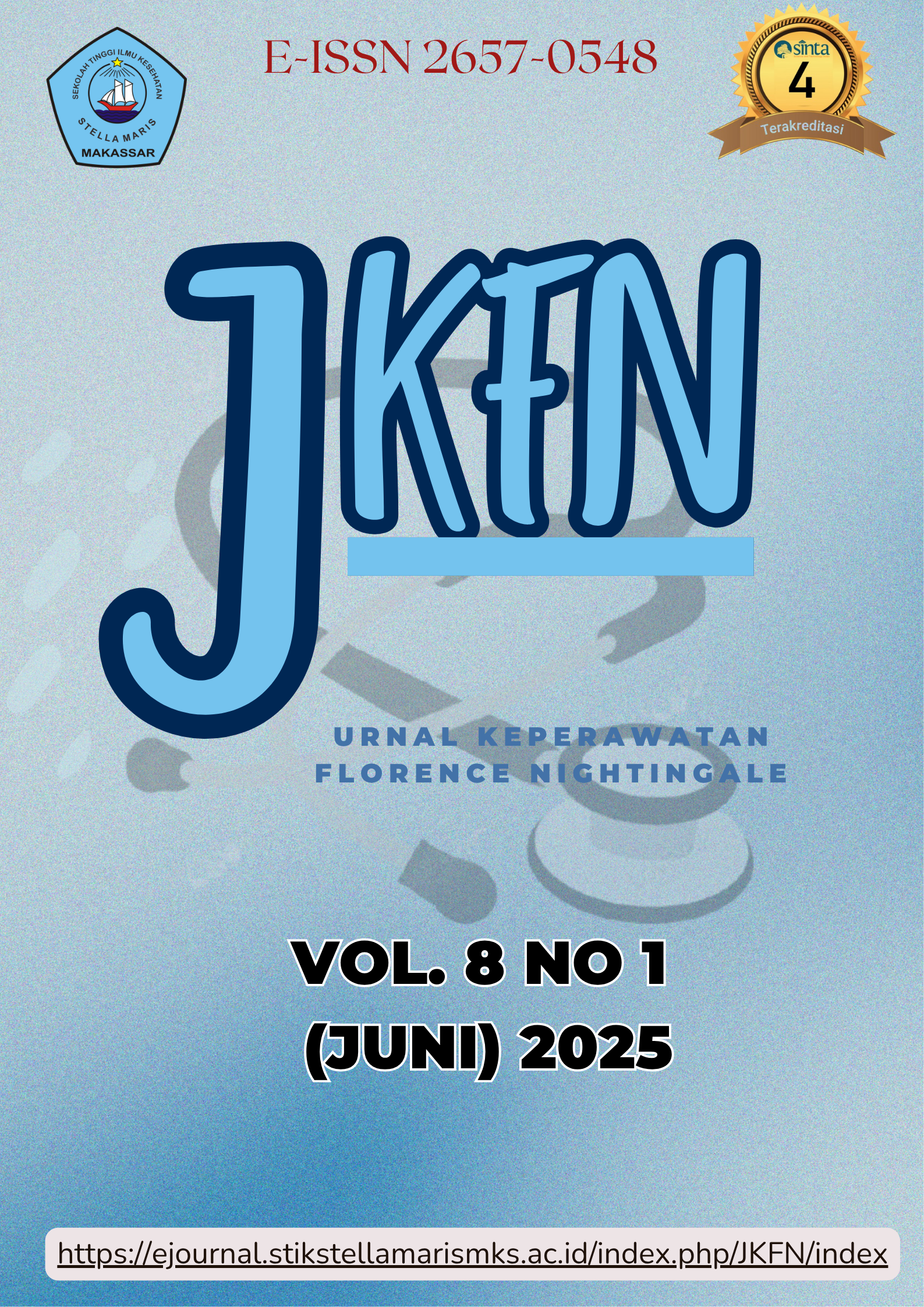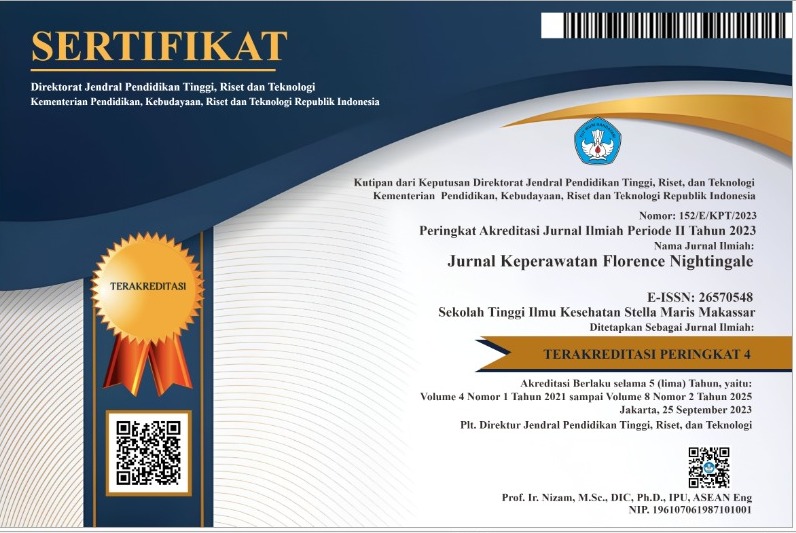The Relationship Between Food Intake In Pregnant Women And The Incidence Of Chronic Energy Deficiency
Keywords:
pregnant woman;, food intake;, chronic energy deficiency (CED)Abstract
Chronic Energy Deficiency (CED) is a condition characterized by an imbalance between energy and protein intake, resulting in the body’s nutritional needs not being adequately met. In Central Sulawesi, the prevalence of pregnant women experiencing CED is 22.7%. To determine the relationship between food intake in pregnant women and the incidence of Chronic Energy Deficiency (CED) in the working area of the Bulili Community Health Center. This study used a quantitative design using a cross-sectional approach. The population consisted of all pregnant women who sought antenatal care at the Bulili Community Health Center. A total sampling technique was used, involving 20 pregnant women. Data were collected using a Semi-Quantitative Food Frequency Questionnaire and analyzed using the Chi-Square Test and Fisher’s Exact Test for interpretation. The results of the study revealed that among pregnant women diagnosed with Chronic Energy Deficiency (CED), 6 individuals (40%) had inadequate energy intake, while 9 individuals (60%) had adequate intake. For carbohydrate intake, 8 individuals (53.3%) had inadequate intake, while 7 individuals (46.6%) had adequate intake. For protein intake, 4 individuals (26.6%) had inadequate intake, while 11 individuals (73.3%) had adequate intake. For fat intake, 2 individuals (13.3%) had inadequate intake, while 13 individuals (86.6%) had adequate intake. The Fisher’s Exact Test showed a p-value > 0.005, indicating that there is no relationship between food intake in pregnant women and the incidence of Chronic Energy Deficiency (CED) in the working area of the Bulili Community Health Center.
Downloads
References
Adhelna, S., Halifah, E., & Ardhia, D. (2022). The Correlation Of Chronic Energy Lack Of Events (CED) With Anemia In Pregnant Women. JJIM FKep, 6(1), 11–17. https://doi.org/10.33490/b.v2i2.383
Almananda, T. C. (2021). Karya tulis ilmiah pada ibu hamil dengan kekurangan energi kronik di puskesmas Mekar Sari. Politeknik Kesehatan Kementriaan Kesehatan Jurusan Keperawatan Prodi DIII Keperawatan Samarinda, 10(2).
Apriliani. (2016). Hubungan Asupan Zat Gizi Makro (Protein, Lemak, Dan Karbohidrat) Dengan Lingkar Lengan Atas (Lila) Pada Ibu Hamil Di Wilayah Kerja Puskesmas Sawah Lebar Kota Bengkulu. In Poltekkes Bengkulu (Vol. 85, Issue 1).
Azizah, A., & Adriani, M. (2018). Tingkat Kecukupan Energi Protein Pada Ibu Hamil Trimester Pertama Dan Kejadian Kekurangan Energi Kronis. Media Gizi Indonesia, 12(1), 21. https://doi.org/10.20473/mgi.v12i1.21-26
Dictara, A. A., Angraini, D. I., Mayasari, D., Karyus, A., Kedokteran, F., Lampung, U., Ilmu, B., Masyarakat, K., & Kedokteran, F. (2020). Hubungan Asupan Makan dengan Kejadian Kurang Energi Kronis ( KEK ) pada Ibu Hamil di Wilayah Kerja Puskesmas Sukaraja Kota Bandar Lampung The Relation Between Food Intake And Chronic Energy Deficiency ( CED ) Of Pregnant Woman In Work Area Sukaraja ’ s He. Majority, 9(2), 1–6. https://juke.kedokteran.unila.ac.id/index.php/majority/article/download/2846/2779
Dinas Kesehatan Provinsi Sulawesi Tengah. (2022). Profil Kesehatan Provinsi Sulawesi Tengah. https://dinkes.sultengprov.go.id/wp-content/uploads/2022/05/PROFILDINAS-KESEHATAN-2021.pdf
Ervinawati, E., Wirda, A., & Nurlisis, N. (2019). Determinant of Chronic Energy Malnutrition (CEM) in Pregnant Woman at Lubuk Muda Public Health Center. Jurnal Kesehatan Komunitas, 4(3), 120–125. https://doi.org/10.25311/keskom.vol4.iss3.289
Fatimah, S., & Yuliani, N. T. (2019). Hubungan Kurang Energi Kronis (Kek) Pada Ibu Hamil Dengan Kejadian Berat Bayi Lahir Rendah (Bblr) Di Wilayah Kerja Puskesmas Rajadesa Tahun 2019. Journal of Midwifery and Public Health, 1(2). https://doi.org/10.25157/jmph.v1i2.3029
Fauziah, H., Thaha, R., & Abdul, S. (2018). Analisis Faktor Risiko Kekurangan Energi Kronik (KEK) Pada Wanita Prakonsepsi di Kota Makassar. Kesehatan Masyarakat, 2(1), 257–263.
Heryunanto, D., Putri, S., Izzah, R., Ariyani, Y., & Kharin Herbawani, C. (2022). Gambaran Kondisi Kekurangan Energi Kronis Pada Ibu Hamil Di Indonesia, Faktor Penyebabnya, Serta Dampaknya. PREPOTIF : Jurnal Kesehatan Masyarakat, 6(2), 1792–1805. https://doi.org/10.31004/prepotif.v6i2.4627
Kementerian Kesehatan RI. (2018). Riset Kesehatan Dasar. Laporan Nasional Riskesndas 2018, 44(8), 181–222. http://www.yankes.kemkes.go.id/assets/downloads/PMK No. 57 Tahun 2013 tentang PTRM.pdf
Mahdiah, M., & Tampubolon, E. R. (2023). The Relationship Between Energy, Protein, and Fat Intake in Pregnant Women with Infant Weight and Length. International Journal of Social Service and Research, 3(11), 2728–2734. https://doi.org/10.46799/ijssr.v3i11.580
Maulinda, A., Nuradhiani, A., & Hanun Siregar Universitas Sultan Ageng Tirtayasa Serang, M. (2024). Hubungan Pendapatan, Pengetahuan, dan Asupan Makanan Terhadap Kekurangan Energi Kronis pada Ibu Hamil di Puskesmas Ciwandan. Jurnal Ilmiah Gizi, 4(Februari), 50–58.
Noviyanti, W., HS, S. A. S., & Hasanah, U. (2022). Penerapan Penyuluhan Kesehatan Tentang Kurang Energi Kronik (KEK) Terhadap Tingkat Pengetahuan Ibu Hami Di Wilayah Kerja Puskesmas Ganjar Agung. Jurnal Cendikia Muda, 2(2), 295–301.
Petrika, Y., Hadi, H., & Nurdiati, D. S. (2016). Tingkat asupan energi dan ketersediaan pangan berhubungan dengan risiko kekurangan energi kronik (KEK) pada ibu hamil. Jurnal Gizi Dan Dietetik Indonesia (Indonesian Journal of Nutrition and Dietetics), 2(3), 140. https://doi.org/10.21927/ijnd.2014.2(3).140-149
Rika, F. D., Wiratmo, P. A., & Lubis, E. (2021). Hubungan Tingkat Pengetahuan Tentang Gizi Terhadap Kejadian Kekurangan Energi Kronik (Kek) Pada Ibu Hamil. Binawan Student Journal, 3(3), 8–15. https://doi.org/10.54771/bsj.v3i3.327
Setiawati, E., & Puspitasari, E. (2023). Karakteristik Ibu Hamil dengan Kekurangan Energi Kronik (KEK) di Wilayah Kerja Puskesmas Galur II. Jurnal Keperawatan AKPER YKY Yogyakarta, 15(2), 1–8.
Syari, M., Serudji, J., & Mariati, U. (2015). Peran Asupan Zat Gizi Makronutrien Ibu Hamil terhadap Berat Badan Lahir Bayi di Kota Padang. Jurnal Kesehatan Andalas, 4(3), 729–736. https://doi.org/10.25077/jka.v4i3.355
Usrina, N., Faisal, B. A., Abdullah, A., Zakaria, R., & Maidar. (2020). The influence of maternal consumptio of energy and protein during the third trimester with birth outcomes : A cohort study. SEL Jurnal Penelitian Kesehatan, 8(2), 86–95.
Wijayanti, I. T. (2019). Pola Makan Ibu Hamil Yang Mempengaruhi Kejadian Kek Di Puskesmas Gabus I Kabupaten Pati. Jurnal SMART Kebidanan, 6(1), 5. https://doi.org/10.34310/sjkb.v6i1.226
Published
How to Cite
Issue
Section
Copyright (c) 2025 Hasnidar, Badariati, Parmin, Sukrang, Magfira (Author)

This work is licensed under a Creative Commons Attribution-ShareAlike 4.0 International License.









